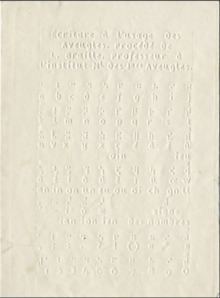Print basis French alphabet | Languages French Time period 1837 | |
 | ||
Parent systems night writingearly brailleFrench Braille | ||
2007 international linguistics olympiad question 1 ioling uklo french braille
French Braille is the original braille alphabet, and the basis of all others. The alphabetic order of French has become the basis of the international braille convention, used by most braille alphabets around the world. However, only the 25 basic letters of the French alphabet plus w have become internationalized; the additional letters are largely restricted to French Braille and the alphabets of some neighboring European countries.
Contents
- 2007 international linguistics olympiad question 1 ioling uklo french braille
- French braille
- Letters
- Punctuation
- Formatting and mode
- Numbers
- History
- Similar alphabets
- References
French braille
Letters
In numerical order by decade, the letters are:
For the purposes of accommodating a foreign alphabet, ö is considered equivalent to œ, and the letters ì, ä, ò may be added:
Unlike English and German Braille, French Braille only uses the abbreviations and contractions present in the printed orthography.
Punctuation
Punctuation is as follows:
The lower values are readings within numbers (after the Antoine number marker: see below).
Formatting and mode
Formatting and mode-changing marks are:
As in English Braille, the capital sign is doubled for all caps.
⟨⠢⟩ and ⟨⠔⟩ are used to begin and end emphasis within a word.
The symbol marker combines with a following initial letter to produce the following:
⠐⠏ §, ⠐⠿ &, ⠐⠉ ©, ⠐⠗ ®, ⠐⠞ ™, ⠐⠬ % (⠐⠬⠬ ‰, ⠐⠬⠬⠬ ‱)The currency marker combines with a following initial for:
⠘⠽ ¥, ⠘⠑ €, ⠘⠎ $, ⠘⠇ £It is also used in comic strips:
⠘⠻ (speech bubble), ⠘⠳ (thought bubble)Numbers
The traditional system of digits is to add the number sign ⠼ in front of the letters of the first decade (a–j), with ⠼⠁ being ⟨1⟩ and ⠼⠚ being ⟨0⟩. This is the internationally recognized number system. However, in French Braille a new system, the Antoine braille digits, is used for mathematics and is recommended for all academic publications. This uses ⠠ combined with the first nine letters of the fourth decade, from ⠠⠡ for ⟨1⟩ to ⠠⠪ for ⟨9⟩, with the preceding ⠠⠼ for ⟨0⟩. The period/decimal and fraction bar also change. The Antoine numbers are being promoted in France and Luxembourg, but are not much used in with French Braille in Quebec.
See the punctuation section above for Antoine mathematical notation.
History
Readings have changed slightly since modern braille was first published in 1837. The greatest change has been various secondary readings which were added to the alphabet and then abandoned.
Similar alphabets
In general, only the assignments of the basic 26 letters of the French alphabet are retained in other braille alphabets. For example, among the additional letters, in German Braille only ü and ö coincide with French Braille. However, there are several alphabets which are much more closely related. Flemish Dutch uses the French Braille alphabet, in contrast to the German-derived Netherlands Dutch Braille. Italian Braille is identical to the French apart from doubling up French Braille ò to Italian ó and ò, since French has no ó. Indeed, a principal difference of these alphabets is the remapping of French vowels with a grave accent (à è ì ò ù) to an acute accent (á é í ó ú), as the French alphabet does not support acute accents apart from é. Spanish changes all five of these vowels, as well as taking ü. Portuguese Braille is also very similar to the French, though the shift of grave to acute accents necessitated a chain of other changes, such as circumflex to grave, and the Portuguese tildes were taken from French diaereses (Portuguese ã õ for French ä ö/œ). The continental Scandinavian languages took the extended French letters â (for å), ä/æ, and ö/ø. Vietnamese Braille is also quite similar, though it has added tone letters, and according uses French ⠵ z for d, which is pronounced like z.
Catalan Braille adds ⠇⠐⠇ for print ⟨l·l⟩, and Spanish Braille uses ⠻ (French ï) for the non-French consonant ñ. Luxembourgish Braille has since switch to eight-point braille, adding a dot at point 8 for the three vowels with accents.
Punctuation and formatting are in general similar as well, though changes in French punctuation over time means that some languages use older French conventions. For example, French parentheses and quotation marks originally had the opposite values they do today, values which remain in English Braille. Other changes have accrued over time, and in some cases vary from country to country. For example, Italian Braille uses the old French quotation marks ⠦⠀⠴ and asterisk ⠔, but also shifted the old French parentheses ⠶⠀⠶ to brackets and innovated ⠢⠀⠔ for parentheses; in addition, it uses point 3, ⠄, for both apostrophe and full stop / period.
